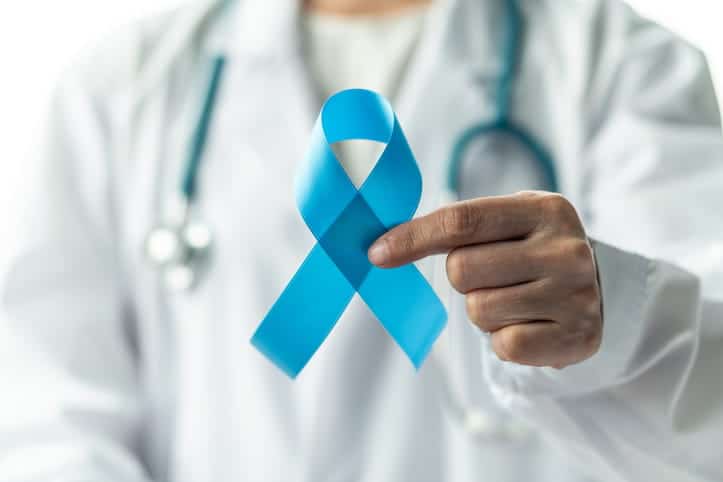
Prostate cancer is the second most common cancer among American men, according to the Centers for Disease Control and Prevention (CDC). Therefore, it’s likely that the possibility causes the majority of males their fair share of anxiety. Keep reading to discover more about prostate cancer and its symptoms.
What is prostate cancer?
According to the CDC, cancer is when something goes wrong with your body’s cells causing certain cells to grow too rapidly. Prostate cancer is when this takes place in the prostate.
What is a prostate?
The prostate is an organ located under the bladder before the rectum with the entirety of the organ surrounding the urethra (the tube that carries the urine from the bladder). The CDC notes that the prostate is responsible for producing seminal fluid and is roughly the size of a walnut.
What causes prostate cancer?
According to the American Cancer Society, prostate cancer is caused by changes in DNA. The exact causes of these changes are unclear, but it’s thought that the changes in the DNA are either inherited from a parent or attained throughout a person’s lifetime through random events or not properly taking care of one’s health.
Related: What Causes COPD?
What are the five warning signs of prostate cancer?
According to the CDC, some men do not display any symptoms in the early stages of prostate cancer and a lot of the symptoms are also symptoms of treatable infections or other issues. Therefore, it’s important not to panic. However, the following can be symptoms of prostate cancer so it’s always best to see your doctor if you have any of the following symptoms:
- Trouble urinating — this includes trouble starting to pee, frequent urination, a weak stream, trouble emptying the bladder completely, or any discomfort during urination
- Erectile dysfunction
- Pain with ejaculation
- Blood in the urine and/or semen
- Persistent pain in the back, hips, or pelvis
How common is prostate cancer?
According to the CDC, prostate cancer is a risk for all men with the likelihood increasing with age and other risk factors. As many as 13% of men will receive a prostate cancer diagnosis in their life.
Prostate cancer risk factors:
- Age
- A family history of prostate cancer, breast cancer, ovarian cancer, or pancreatic cancer
- African American descent
How to prevent prostate cancer
According to the Mayo Clinic, the following are the best ways to prevent prostate cancer:
- Keep your weight at a healthy number
- Include a medley of fruits, vegetables, and whole grains in your diet
- Maintain an adequate intake of vitamins and minerals through diet as opposed to supplements
- Get plenty of exercise
- Discuss your risk factors for prostate cancer with your doctor
What are the four stages of prostate cancer?
According to the American Society of Clinical Oncology (ASCO), there are two types of staging with prostate cancer – clinical staging and pathological screening. Clinical staging is the process of gathering data on a specific case through a digital rectal exam (DRE), prostate-specific antigen (PSA) testing, and the Gleason score (based on how the cancer cells look under a microscope). These tests help the doctor determine if additional testing is needed. Pathological screening is when doctors run tests and examine the actual cancerous tissue from the inside of the body after surgery.
The 4 stages of prostate cancer (according to the ASCO):
Stage 1 — usually slow-growing and only takes up part of one side of the prostate, the PSA levels are low, and the cancer cells still look healthy. This stage cannot usually be felt by the patient.
Stage 2 — cancer is still limited to the prostate but may have an increased risk of spreading. The tumor is still small, PSA numbers are still low to mid-range, the cancer cells begin to look abnormal, and the tumor may be able to be felt during a DRE.
Stage 3 — high PSA levels, cancer cells that have differentiated from healthy cells, and a growing tumor.
Stage 4 — cancer has spread outside of the prostate. Generally, the cancer will initially spread to the regional lymph nodes then to the distant lymph nodes, other various parts of the body, and possibly even the bones.
What are the signs that prostate cancer has spread?
According to the ASCO, in the case that prostate cancer has metastasized (spread) to other parts of the body, the symptoms can include:
- Lethargy
- Pain in the bones
- Losing weight without cause
- Fluid buildup and/or swelling in the feet and/or legs
- Variations in bowel habits
How to check for prostate cancer
According to the Cleveland Clinic, the tests done to check for early warning signs of prostate cancer are the prostate-specific antigen (PSA) test and the digital rectal exam (DRE). The PSA test is a blood test, and the DRE is when a doctor inserts a gloved finger into the rectum to feel the prostate for any abnormalities. Generally, these tests are recommended together as neither is a foolproof way to detect the presence of cancer.
Related: What is Cognitive Behavior Therapy
Can you check for prostate cancer at home?
If you’re concerned, it is better to have a doctor run the tests as this is a difficult cancer to diagnose and it’s better not to give yourself unnecessary anxiety.
What foods kill prostate cancer cells?

Diet isn’t a treatment plan. However, according to the Prostate Cancer Foundation, adding the following foods to your diet may discourage cancer cell growth and improve prostate health:
- Cruciferous veggies such as Brussels sprouts, cabbage, kale, bok choy, cauliflower, and broccoli
- Berries such as strawberries, blueberries, blackberries, and raspberries
- Cooked tomatoes
- Fish such as salmon, trout, and sardines
- Coffee and tea (without sweeteners)
Prostate cancer is scary, but the prognosis (when caught in the early stages) is actually quite good. In fact, according to Johns Hopkins Medicine, due to early detection through cancer screenings, the majority of prostate cancers are caught early and are curable. This makes the ten-year survival rate with prostate cancer roughly 98%. By knowing the symptoms of prostate cancer, talking to your doctor about your risk factors, and being regularly screened, you can (hopefully) catch prostate cancer early.
For individualized inpatient and outpatient services for rehabilitation, skilled nursing services, and more, check out Haven Health.
Citations:
Prostate Cancer. (2022).
Prostate Cancer: Stages and Grades. (2022).
Prostate Cancer: Symptoms and Signs. (2022).
Prostate Exam. (2022).
What Causes Prostate Cancer? (2019).
What Is Prostate Cancer?, CDC (2022).